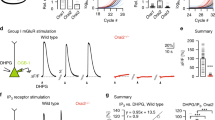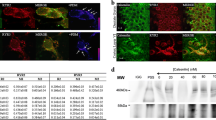Abstract
The ryanodine-sensitive intracellular Ca2+ stores are known to play a major role in excitation-contraction coupling in muscles. Although these stores are also abundantly present in central neurons, their functional role in these cells remains unclear. Using fluorometric digital imaging of the intracellular Ca2+ concentration ([Ca2+] i ) in rat hippocampal slices, we investigated the dynamic properties of the ryanodine-sensitive Ca2+ stores inCA1 hippocampal pyramidal cells. We found that at rest the ryanodine-sensitive Ca2+ stores are functioning predominantly as a “sink” for Ca ions responding to an increase in [Ca2+] i with an increase in the amount of Ca ions accumulated inside the stores. If, however, [Ca2+] i increases significantly, as happens during strong neuronal discharges, the ryanodine-sensitive Ca2+ stores respond with Ca2+ release, thus acting as an amplifier of the intracellular Ca2+ signal.
Similar content being viewed by others
References
A. H. Sharp, P. S. McPherson, T. M. Dawson, et al., “Differential immunohistochemical localization of inositol 1,4,5-trisphosphate-and ryanodine-sensitive Ca2+ release channels in rat brain,”J. Neurosci.,13, 3051–3063 (1993).
T. Furuichi, D. Furutama, Y. Hakamata, et al., “Multiple types of ryanodine receptor/Ca2+ release channels are differentially expressed in rabbit brain,”J. Neurosci.,14, 4794–485 (1994).
J. Holliday, R. J. Adams, T. J. Sejnowski, and N. C. Spitzer, “Calcium-induced release of calcium regulates differentiation of cultured spinal neurons,”Neuron,7, 787–796 (1991).
S. Y. Hua, M. Nohmi, and K. Kuba, “Characteristics of Ca2+ release induced by Ca2+ influx in cultured bullfrog sympathetic neurons,”J. Physiol.,464, 245–272 (1993).
I. Llano, R. DiPolo, and A. Marty, “Calcium-induced calcium release in cerebellar Purkinje cells,”Neuron,12, 663–673 (1994).
M. Kano, O. Garaschuk, A. Verkhratsky, and A. Konnerth, “Ryanodine receptor-mediated intracellular calcium release in rat cerebellar Purkinje neurons,”J. Physiol.,487, 1–16 (1995).
A. Shmigol, A. Verkhratsky, and G. Isenberg, “Calcium-induced calcium release in rat sensory neurons,”J. Physiol.,489, 627–636 (1995).
A. Fabiato, “Calcium-induced release of calcium from the cardiac sarcoplasmic reticulum,”Am. J. Physiol.,245, C1–14 (1983).
M. Nabauer, G. Callewaert, L. Cleemann, and M. Morad, “Regulation of calcium release is gated by calcium current, not gating charge, in cardiac myocytes,”Science,244, 800–803 (1989).
S. Alford, B. G. Frenguelli, J. G. Schofield, and G. L. Collingridge, “Characterization of Ca2+ signals induced in hippocampalCA1 neurons by the synaptic activation of NMDA receptors,”J. Physiol.,469, 693–716 (1993).
R. J. Miller, “Neuronal Ca2+: getting it up and keeping it up,”Trends Neurosci.,15, 317–319 (1992).
A. Schiegg, W. Gerstner, R. Ritz, and J. L. van Hemmen, “Intracellular Ca2+ stores can account for the time course of LTP induction: a model of Ca2+ dynamics in dendritic spines,”J. Neurophysiol.,74 1046–1055 (1995).
Y. Wang, J. Wu, M. J. Rowan, and R. Anwyl, “Ryanodine produces a low frequency stimulation-induced NMDA receptor-independent long-term potentiation in the rat dentate gyrusin vitro,”J. Physiol.,495, 755–767 (1996).
A. Shmigol, S. Kirischuk, P. Kostyuk, and A. Verkhratsky, “Different properties of caffeine-sensitive Ca2+ stores in peripheral and central mammalian neurons,”Pflügers Arch.,426, 174–176 (1994).
J. R. Brorson, D. Bleakman, S. J. Gibbons, and R. J. Miller, “The properties of intracellular calcium stores in cultured rat cerebellar neurons,”J. Neurosci.,11, 4024–4043 (1991).
P. B. Simpson, R. A. Challiss, and S. R. Nahorski, “Neuronal Ca2+ stores: activation and function,”Trends Neurosci,18, 299–306 (1995).
D. D. Friel and R. W. Tsien, “A caffeine- and ryanodine-sensitive Ca2+ store in bullfrog sympathetic neurons modulates effects of Ca2+ entry on [Ca2+] i ,”J. Physiol.,450, 217–246 (1992).
H. Markram, P. J. Helm, and B. Sakmann, “Dendritic calcium transients evoked by single back-propagating action potentials in rat neocortical pyramidal neurons,”J. Physiol.,485, 1–20 (1995).
O. Garaschuk, R. Schneggenburger, C. Schirra, et al., “Fractional Ca2+ currents through somatic and dendritic glutamate receptor channels of rat hippocampalCA1 pyramidal neurons,”J. Physiol.,491, 757–772 (1996).
F. A. Edwards, A. Konnerth, B. Sakmann, and T. Takahashi, “A thin slice preparation for patch clamp recordings from neurons of the mammalian central nervous system,”Pflügers Arch.,414, 600–612 (1989).
J. Eilers, R. Schneggenburger, and A. Konnerth “Patch clamp and calcium imaging in brain slices,” in:Single Channel Recording, B. Sakmann and E. Neher (eds.), Plenum Publishing Co., New York (1995), pp. 213–229.
O. Garaschuk and A. Konnerth, “Quantitative calcium imaging in brain slices,” in:Imaging Living Cells, R. Rizzuto and C. Fasolato (eds.), Landes/Springer, Austin (in press).
E. Neher, “Combined fura-2 and patch clamp measurements in rat perioneal mast cells,” in:Neuromuscular Junction, L. Sellin, R. Libelius, and S. Thesleff (eds.), Elsevier, Amsterdam (1989). pp. 65–76.
O. Garaschuk, Y. Yaary, and A. Konnerth, “Release and sequestration of calcium by ryanodine-sensitive stores in rat hippocampal neurons,”J. Physiol.,502, 13–30 (1997).
K. J. Seymour-Laurent and M. E. Barish, “Inositol 1,4,5-trisphosphate and ryanodine receptor distributions and patterns of acetylcholine- and caffeine-induced calcium release in cultured mouse hippocampal neurons,”J. Neurosci,15, 2592–2608 (1995).
T. Pozzan, R. Rizzuto, P. Volpe, and J. Meldolesi, “Molecular and cellular physiology of intracellular calcium stores,”Physiol. Rev.,74, 595–636 (1994).
A. Shmigol, P. Kostyuk, and A. Verkhratsky, “Role of caffeine-sensitive Ca2+ stores in Ca2+ signal termination in adult mouse DRG neurons,”NeuroReport,5, 2073–2076 (1994).
V. Henzi and A. B. MacDermott, “Characteristics and function of Ca2+-and inositol 1,4,5-trisphosphate-releasable stores of Ca2+ in neurons,”Neuroscience,46, 251–273 (1992).
A. Shmigol, N. Svichar, P. Kostyuk, and A. verkhratsky, “Gradual caffeine-induced Ca2+ release in mouse dorsal root ganglion neurons is controlled by cytoplasmic and luminal Ca2+,”Neuroscience,73, 1061–1067 (1996).
Author information
Authors and Affiliations
Rights and permissions
About this article
Cite this article
Garaschuk, O., Konnerth, A. Dual role of ryanodine-sensitive calcium stores in central neurons. Neurophysiology 29, 199–204 (1997). https://doi.org/10.1007/BF02461229
Received:
Issue Date:
DOI: https://doi.org/10.1007/BF02461229




